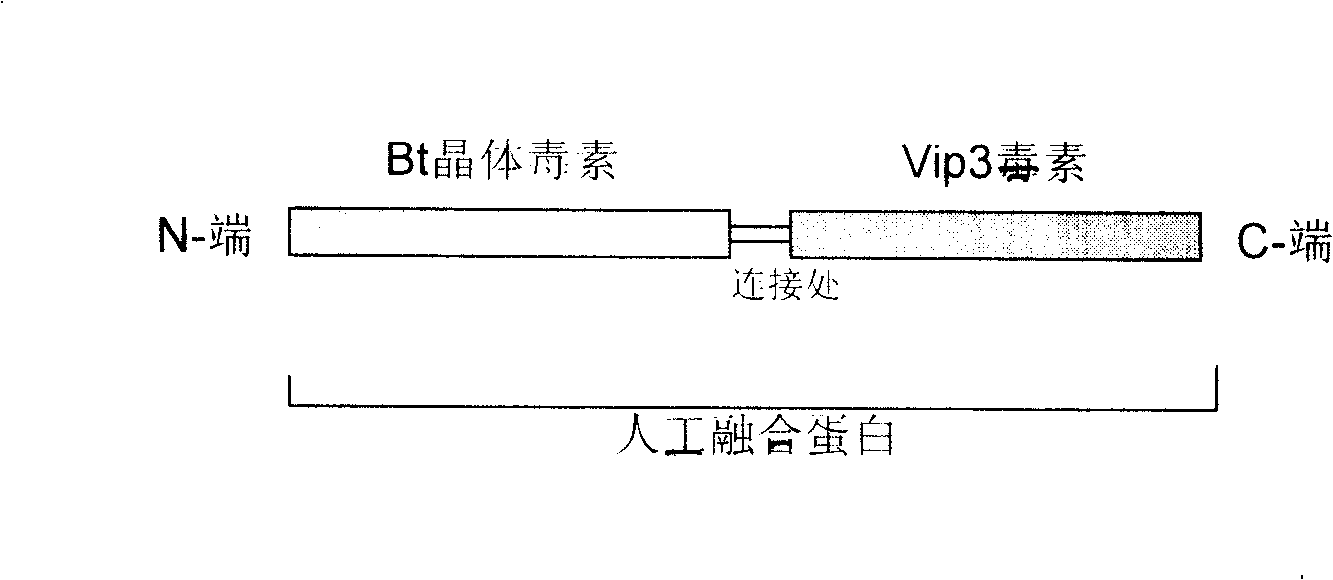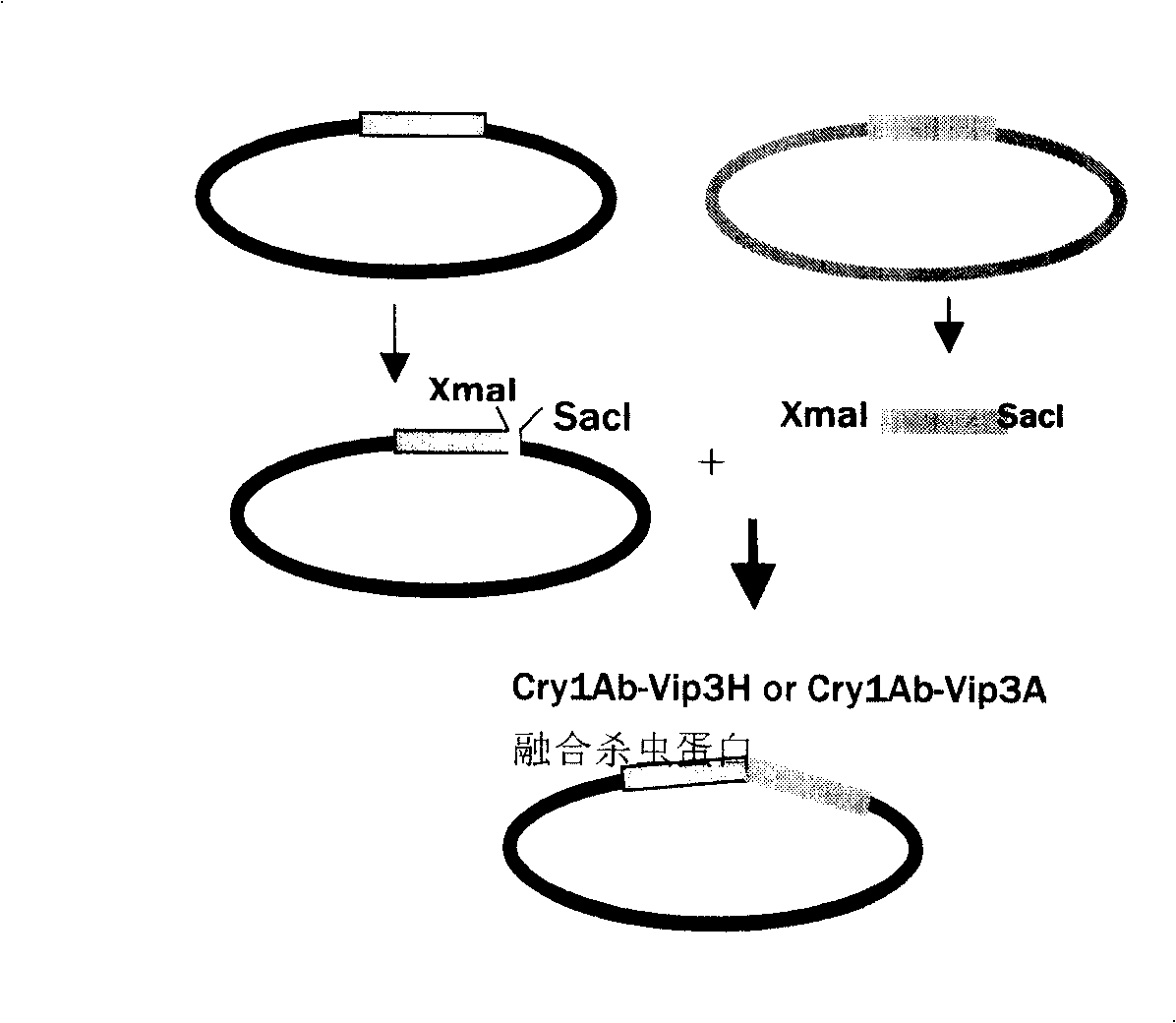Zoophobous fusion protein and use thereof
A fusion gene and fusion protein technology, which is applied in the specific application field of fusion protein, can solve the problems of narrow insecticidal spectrum, low insecticidal ability, affecting the insect resistance and availability of crystal toxins, and achieve the slowdown of pest resistance , Broad-spectrum insecticidal effect
- Summary
- Abstract
- Description
- Claims
- Application Information
AI Technical Summary
Problems solved by technology
Method used
Image
Examples
Embodiment 1
[0021] Example 1, Preparation of Cry1Ab-Vip3H fusion toxin gene:
[0022] The genes encoding Cry1Ab and Vip3H insecticidal proteins were synthesized by Shanghai Sangong, and their DNA sequences were respectively SEQ ID NO: 5 and SEQ ID NO: 6, and were cloned at the positions of the restriction endonucleases BamHI and SacI of the PET28a expression vector between points.
[0023] The synthesis process of Cry1Ab-Vip3H is as follows figure 2 As shown, the specific steps are as follows:
[0024] 1. The Vip3H gene fragment was obtained by PCR with the following two primers: V3HN 5'CTCCCC CGG GCC AGG TGG AAG TAA GCT CTC CAC CCG CGC CCT C, and V3HC 5'TCT TGA GCT CCT ACT TGA TGC TCA CGT CGT AGA AGT GCA. These two primers contain sites for the restriction enzymes XmaI and SacI, respectively. The template for PCR was Vip3H (SEQ ID NO: 6).
[0025] 2. Treat the PCR product with XmaI and SacI, and connect it with the pET28a-Cry1Ab vector treated with the same enzyme.
[0026] 3. Tran...
Embodiment 2
[0027] Example 2, Preparation of Cry1Ab-Vip3A fusion toxin gene:
[0028] The genes encoding Cry1Ab and Vip3A insecticidal proteins were synthesized by Shanghai Sangong, and their DNA sequences were SEQ ID NO: 5 and SEQ ID NO: 7, respectively, and were cloned at the positions of the restriction endonucleases BamHI and SacI of the PET28a expression vector between points.
[0029] The synthesis process of Cry1Ab-Vip3A is as follows figure 2 As shown, the specific steps are as follows:
[0030] 1. The Vip3H gene fragment was obtained by PCR with the following two primers: V3AN 5'GGCCCC GGG ACC AAG CTG AGC ACC AGG GCC, and V3AC 5'TCT TGA GCTCCT ACT TGA TGC TCA CGT CGT AGA ACT TCA CG. These two primers contain sites for the restriction enzymes XmaI and SacI, respectively. The template for PCR was Vip3H (SEQ ID NO: 7).
[0031] 2. Treat the PCR product with XmaI and SacI, and connect it with the pET28a-Cry1Ab vector treated with the same enzyme.
[0032] 3. Transform into Esch...
Embodiment 3
[0033] Example 3, Preparation of Cry1Ab-Vip3H fusion protein:
[0034] The expression vector pET28a-Cry1Ab-Vip3H containing the fusion protein gene was transformed into Escherichia coli BL21star using a general standard method. A single colony was inoculated into 100 ml of LB bacterial culture medium, and cultured with shaking at 37°C until OD 600 =0.6, add IPTG to 0.5mM, continue to culture under the same conditions for 4 hours. The culture solution was centrifuged at 5000 g for 10 minutes to pellet the E. coli cells, and then the supernatant was discarded to collect the pellet. Add 30 ml of 20mM Tris-HCl buffer solution to the precipitate and ultrasonically pulverize it for the determination of insecticidal activity.
PUM
 Login to View More
Login to View More Abstract
Description
Claims
Application Information
 Login to View More
Login to View More - R&D
- Intellectual Property
- Life Sciences
- Materials
- Tech Scout
- Unparalleled Data Quality
- Higher Quality Content
- 60% Fewer Hallucinations
Browse by: Latest US Patents, China's latest patents, Technical Efficacy Thesaurus, Application Domain, Technology Topic, Popular Technical Reports.
© 2025 PatSnap. All rights reserved.Legal|Privacy policy|Modern Slavery Act Transparency Statement|Sitemap|About US| Contact US: help@patsnap.com


